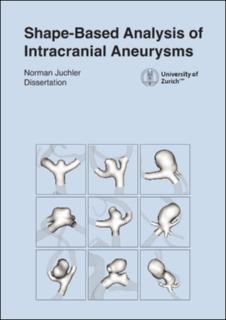Please use this identifier to cite or link to this item:
https://doi.org/10.21256/zhaw-22031| Publication type: | Doctoral thesis |
| Title: | Shape-based analysis of intracranial aneurysms |
| Authors: | Juchler, Norman |
| Advisors / Reviewers: | Kurtcuoglu, Vartan Hirsch, Sven Pajarola, Renato |
| DOI: | 10.5167/uzh-200995 10.21256/zhaw-22031 |
| Extent: | 144 |
| Issue Date: | 27-Aug-2020 |
| Publisher / Ed. Institution: | University of Zurich |
| Language: | English |
| Subjects: | Intracranial aneurysm; Morphology; Shape analysis; Rater-based analysis; Data science |
| Subject (DDC): | 005: Computer programming, programs and data 616: Internal medicine and diseases |
| Abstract: | Intracranial aneurysms (IAs) are malformations of larger arteries in the brain that are associated with a structural weakening of the vessel wall. Unruptured IAs are prevalent in 2-5% of the population and are detected ever more frequently due to the increased availability of medical imaging. Albeit the majority of IAs develops asymptomatically, the rare rupture of an IA causing a subarachnoid hemorrhage can have detrimental effects on the patient’s health or even cause the patient’s death. Therefore, clinicians are more often faced with difficult treatment decisions where they must weigh the costs of treatment against the risks of aneurysms to rupture. So far it is not possible to non-invasively determine the condition of the affected vessel wall region. Clinicians are therefore seeking for biomarkers that describe the structural stability of IAs. IA morphology, as seen in angiographic imaging, holds the potential for such a biomarker. Recent pathobiological studies suggest that structural wall instability is reflected in the geometry of the aneurysm lumen. This thesis project investigated the imaging-based morphological assessment of IAs. A first, data-driven approach, was based on a quantitative shape analysis derived on 3D surface geometries of 750 aneurysms. The author benchmarked established and novel morphometric parameters in terms of their predictive capacity for the disease status of the aneurysm, with the non-sphericity index and normalized Zernike energies performing best. He observed that shape is a stronger predictor for disease status than aneurysm size alone and confirmed the existing belief that IA morphology is associated with rupture. A second, psychometric approach, addressed the indistinct notion of morphological irregularity used by clinicians to characterize IA shape. Based on rating data from 13 clinical experts and 26 laypersons, the perceived irregularity of 134 aneurysms was quantified and used to identify the morphological constituents of overall irregularity. The author demonstrated that irregularity represents a continuous characteristic, with the risk of rupture increasing as the irregularity increases. Both approaches revealed a pronounced dependency of the shape on the anatomical location of the aneurysm. Combining shape and location substantially improved the accuracy of classification models for the IA rupture status. Other clinical aspects such as patient sex, age, smoking status or a history of blood hypertension did not play a significant role in the experiments. For future work, it is of great importance that the scientific community establishes a reference database to which new datasets can be related. In terms of morphology, the AneuX morphology database, which was developed in the context of this thesis project, could serve as such a reference. This thesis provides a refined, standardized taxonomy for morphological characteristics and offers a methodology to quantify subjective assessments of shape by humans. It contributes a software toolbox for morphometric analyses, and a new multicentric database comprising 750 aneurysms. Based on the comprehensive study of quantitative shape features, the author promotes the use of non-sphericity and an objective notion of irregularity for the clinical assessment IA shape. |
| URI: | https://digitalcollection.zhaw.ch/handle/11475/22031 |
| License (according to publishing contract): | CC BY 4.0: Attribution 4.0 International |
| Restricted until: | 2021-06-04 |
| Departement: | Life Sciences and Facility Management |
| Organisational Unit: | Institute of Computational Life Sciences (ICLS) |
| Published as part of the ZHAW project: | AneuX |
| Appears in collections: | Publikationen Life Sciences und Facility Management |
Files in This Item:
| File | Description | Size | Format | |
|---|---|---|---|---|
| 2020_Juchler-Shape-based-analysis-of-intracranial-aneurysms.pdf | 23.37 MB | Adobe PDF |  View/Open |
Show full item record
Juchler, N. (2020). Shape-based analysis of intracranial aneurysms [Doctoral dissertation, University of Zurich]. https://doi.org/10.5167/uzh-200995
Juchler, N. (2020) Shape-based analysis of intracranial aneurysms. Doctoral dissertation. University of Zurich. Available at: https://doi.org/10.5167/uzh-200995.
N. Juchler, “Shape-based analysis of intracranial aneurysms,” Doctoral dissertation, University of Zurich, 2020. doi: 10.5167/uzh-200995.
JUCHLER, Norman, 2020. Shape-based analysis of intracranial aneurysms. Doctoral dissertation. University of Zurich
Juchler, Norman. 2020. “Shape-Based Analysis of Intracranial Aneurysms.” Doctoral dissertation, University of Zurich. https://doi.org/10.5167/uzh-200995.
Juchler, Norman. Shape-Based Analysis of Intracranial Aneurysms. University of Zurich, 27 Aug. 2020, https://doi.org/10.5167/uzh-200995.
Items in DSpace are protected by copyright, with all rights reserved, unless otherwise indicated.